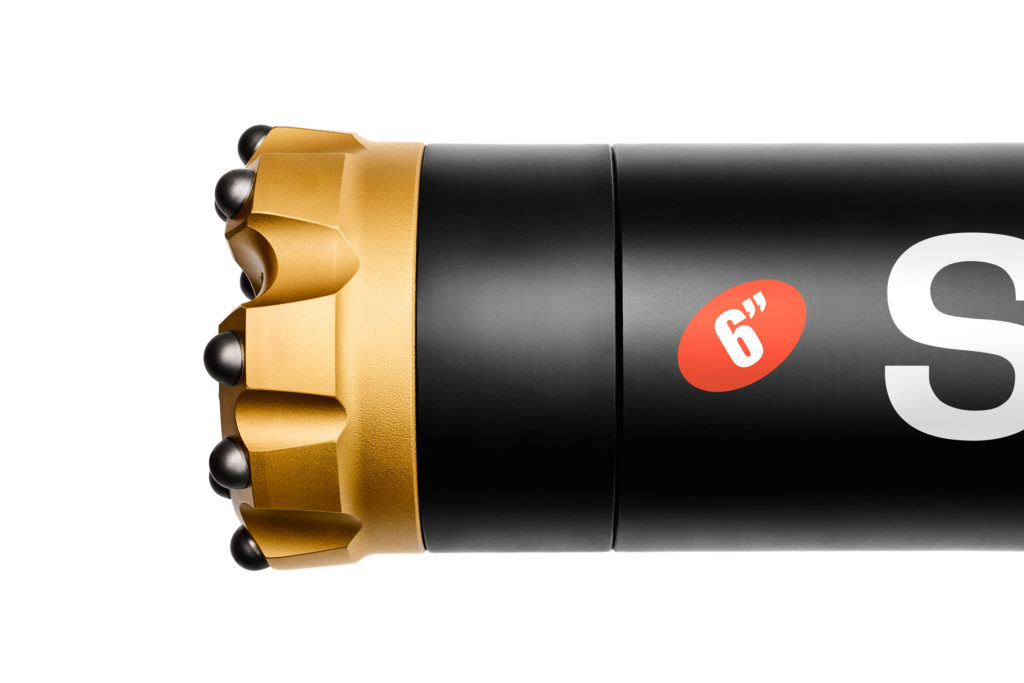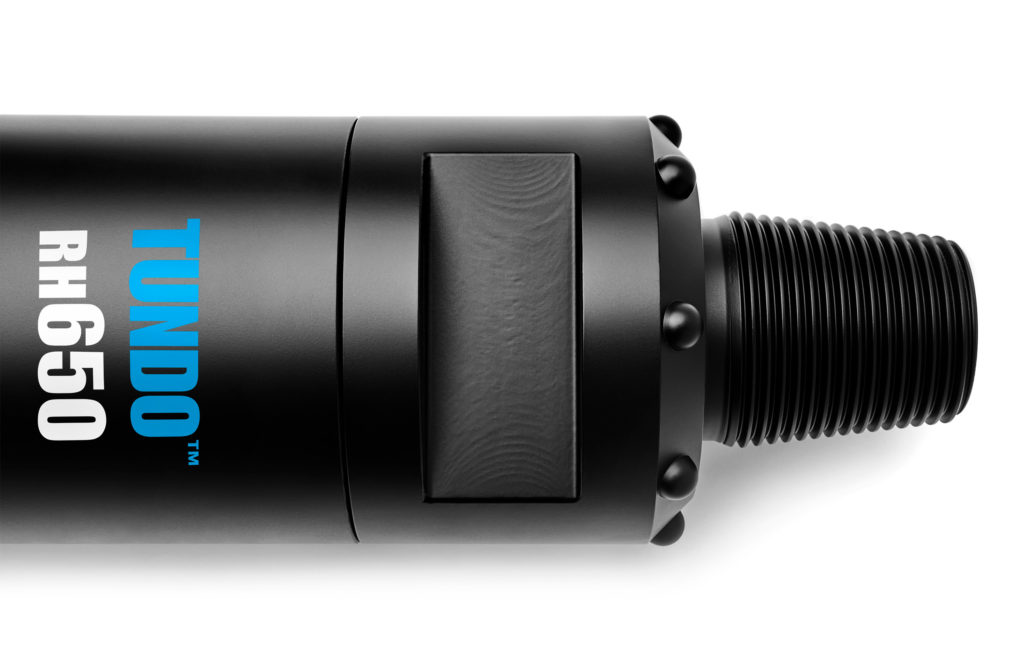Sustainably On Top
What if all down-the-hole drill rigs could eliminate up to one-fifth of their fuel consumption? From a sustainability standpoint, the impact would be enormous, but so too would the impact on companies’ bottom line. The new TUNDO RH650 hammer means to do that right now.
Engineers are curious creatures. They like to tweak and tinker with their products on a never-ending quest for a simpler, more elegant solution. Always aiming for better productivity at a lower cost and reduced emissions, of course. Sometimes the improvements are gradual, and sometimes the new approach offers a revolutionary leap in efficiency.
Revolution is a big word, but it’s not so far-fetched as it might sound when talking about Sandvik Mining and Rock Solutions’ latest innovation in down-the-hole drilling: TUNDO RH650 DTH hammer.
It all started from a crude pencil sketch on graph paper and a simple question: What if we use a solid piston in a DTH hammer instead of the conventional hollow design, making it possible to substantially decrease the length of the piston?
The load on the compressor goes hand in hand with the fuel consumption. To have a hammer that can deliver the same power, but at lower air flow requirements, therefore translates into lower compressor loads, and thus leads to fuel savings.
The new solid piston hammer does exactly that. It can run at lower airflows and still maintain high pressure and deliver high penetration rates. If the compressor allows for higher pressure (30 bars) you can get additional productivity gains compared with conventional hammers.
“Solid pistons enabled us to design a compact, high productivity hammer,” explains Johan Bergquist, product manager, DTH Hammers, Sandvik Mining and Rock Solutions.
In other words, this new solid piston design results in a smaller, lighter hammer – roughly 20 percent shorter than a comparable standard DTH hammer. The weight reduction, which is proportional to the length, is similarly around 20 percent.
Both drill rig operators and maintenance crews will certainly be glad about the smaller size of the hammer, as it means easier and safer handling.
Smaller, lighter DTH hammers are also less costly to transport. In fact, less is more in virtually any area over the life cycle of a DTH hammer, and not least in the CO2 footprint, which is reduced in life-cycle stages of the hammer, ranging from manufacturing through all the operational stages until it is discarded.
Elegance in engineering also means simplicity. One example of this in the new TUNDO RH650 is the fact that the piston design has no foot valve, eliminating one source of faults and maintenance issues.
The reduced air consumption of the hammer also makes it compatible with five-inch and six-inch drill rigs. Yet another improvement is a simpler design in the drill bit, where the change into a solid piston relocates the bulk of air flow into splines, providing superior lubrication.
Focusing on the most common six-inch DTH hammers, conventional designs require an air flow ranging between 23 and 25 cubic metres per minute at a 24-bar operating pressure, which generally necessitates a drill rig in the six-inch class. The standard five-inch rigs are generally not capable of producing this kind of air flow with flow and pressure. Here the TUNDO RH650 DTH hammer and its air efficiency change the game remarkably, thanks to the ability to downsize the drill rig to the more affordable five-inch class.
/https%3A%2F%2Fsolidground.sandvik%2Fwp-content%2Fuploads%2F2023%2F01%2FSandvik-Rock-Tools-Juni-2021-1378_2500px.jpg) An example of the TUNDO’s smart design is that the piston has no foot valve, eliminating one source of faults and maintenance issues.
" />
An example of the TUNDO’s smart design is that the piston has no foot valve, eliminating one source of faults and maintenance issues.
" />An example of the TUNDO’s smart design is that the piston has no foot valve, eliminating one source of faults and maintenance issues.
In addition to the lower capex of a smaller machine, this means that the same productivity can be maintained with lower air consumption – again directly reducing both the fuel cost and CO2 emissions.
Some mine operators or quarry owners may also appreciate the better mobility and easier relocations afforded by a smaller rig. If the choice nevertheless falls on a large six-inch rig, such as the new Leopard DI650i DTH, perhaps due to operational reasons, the new TUNDO RH650 DTH hammer offers significantly higher productivity at 30 bars.
TUNDO RH650 hammer’s significant advantages were verified in comprehensive field tests, which included both conventional Sandvik DTH hammers and products from key competitors. The results show substantial reductions in air consumption compared with all comparable hammer designs, ranging from around 10 percent to more than 30 percent.
These kinds of percentages translate to substantial figures in fuel litres and opex dollars. Assuming a mine operating some 15 Leopard DI650i DTH drill rigs, each racking up 5,500 hours per year, the resulting reduction in diesel consumption would be 3.3 million litres. CO2 emissions would see similar reductions.
Tundo RH650 DTH hammer – Benefits
- Enables drill rig downsizing: lower capex
- Boosts drilling productivity: more metres drilled
- Lower fuel consumption: major cost reduction, lower CO2 emissions
- Lighter and shorter design: easier and safer handling, lower CO2 emissions from transport.
“You can never be totally satisfied in this industry, because the moment you fall too much in love with your product, the progress stops,” Bergquist says. “And that’s something we really can’t afford, considering all the productivity and sustainability challenges our customers are facing. But TUNDO is truly a remarkable step in DTH drilling and something to be proud of. For a moment, I think we can just be really happy about it. Until we make something even better.”

/https%3A%2F%2Fsolidground.sandvik%2Fwp-content%2Fuploads%2F2023%2F01%2Ftundo_rh650_keyvisual_2_2500px.jpg)
 The design of the TUNDO ultimately means easier and safer handling for operators and maintenance crews. " />
The design of the TUNDO ultimately means easier and safer handling for operators and maintenance crews. " /> Even the CO
Even the CO/https%3A%2F%2Fsolidground.sandvik%2Fwp-content%2Fuploads%2F2023%2F05%2FRecycling_Factory_Stills1_2023.jpg)
/https%3A%2F%2Fsolidground.sandvik%2Fwp-content%2Fuploads%2F2023%2F01%2Ftundo_rh650_keyvisual_2_2500px.jpg)
/https%3A%2F%2Fsolidground.sandvik%2Fwp-content%2Fuploads%2F2021%2F11%2FTHXL_Key_visual_3.0_1600x570.jpg)
/https%3A%2F%2Fsolidground.sandvik%2Fwp-content%2Fuploads%2F2019%2F09%2FRammer-5011-quarrying_41879_1600x570.jpg)
/https%3A%2F%2Fsolidground.sandvik%2Fwp-content%2Fuploads%2F2019%2F06%2FSG_cover_1600x570.jpg)
/https%3A%2F%2Fsolidground.sandvik%2Fwp-content%2Fuploads%2F2016%2F12%2Fdeadline-defeated_1366x450.jpg)
/https%3A%2F%2Fsolidground.sandvik%2Fwp-content%2Fuploads%2F2015%2F02%2FHoF1.jpg)
/https%3A%2F%2Fsolidground.sandvik%2Fwp-content%2Fuploads%2F2014%2F12%2FBorynia_094.jpg)
/https%3A%2F%2Fsolidground.sandvik%2Fwp-content%2Fuploads%2F2014%2F12%2FJSW_Poland2.jpg)
/https%3A%2F%2Fsolidground.sandvik%2Fwp-content%2Fuploads%2F2014%2F05%2FMcArthur_Tara1.jpg)
/https%3A%2F%2Fsolidground.sandvik%2Fwp-content%2Fuploads%2F2014%2F04%2Fkanadagruva11.jpg)
/https%3A%2F%2Fsolidground.sandvik%2Fwp-content%2Fuploads%2F2014%2F04%2Fkanadagruva021.jpg)